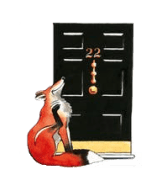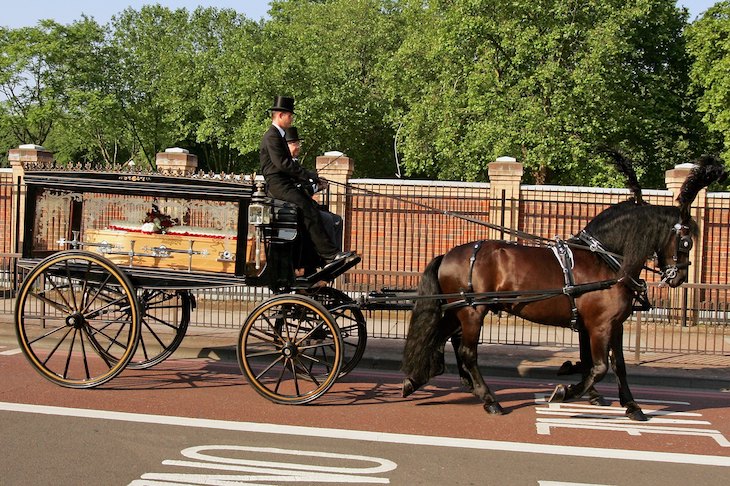Bev died, aged 61. She was the wife of ‘Foxy’ John, kennel huntsman of our local hunt. Bev was the matriarch of the clan, with six children, 14 grandchildren, and other young people in need of help whom she cared for. Both John and Bev have Traveller ‘heritage’. That requires a Traveller funeral. Only the best would do. Bev was laid out for three days in an open coffin, lined in pink, in their rural council house — the only council house I know which plays host to a hunt meet. In the course of the wake, 500 guests somehow crammed in. As custom demands, the people of the house did not sleep. As is also the custom, a pyre consumed her possessions.
On Monday, I drove there. The coffin was borne off on a glass-sided hearse drawn by horses with black plumes and driven by two men in tall hats. Behind the hearse came several black stretch limos, and behind them, two lorries displaying the floral tributes (‘MUM’, ‘LUV U EVERMORE’), and a great heart-shaped balloon with a picture of John and Bev on it. A huge procession of cars, driving at 7 mph behind the horses, made for Eastbourne Crematorium via Hailsham High Street. Outside Eastbourne, the cortege was joined and led by our huntsman-master, in his red coat with a black armband, and by John and Bev’s daughter Macaylla, on her coloured pony Daisy. A van coming the other way stopped out of respect, thus holding up the traffic behind him for ten minutes. No one protested. At the gates of the crematorium, a couple of hounds greeted Bev. The journey had slowed East Sussex for an hour and a half.
Huge crowds, part farmers and county people, but mainly Travellers, quickly filled the service hall, the side hall, and, in steady drizzle, the gardens of the crem. Outside, someone released several doves in tribute. Within, the family were too overcome to deliver their memories, so this was done by the crem official. Her correct tones sounded surreal in the context. One of Bev’s sons gave an example of his mother’s love. His teacher had shoved him across the classroom unjustly. Bev was incensed. She punched the teacher so hard that she broke a finger: ‘I loved her for that.’ Once, the same boy, larking on a motorbike, fell, severely gashing his head: ‘When I came home her knock hurt more than the bloody stitches,’ he recalled approvingly.
John’s tribute was also read out. Here I amalgamate two versions, one delivered at a meet, the other at the funeral: ‘I first met Bev in Welbeck Road, Carshalton, in February 1978. I’d just got off a bus when I saw this beautiful girl. Not looking where I was going, I fell down some steps and was knocked out. I woke up in front of the woman I knew I was going to call my wife. She said, “Are you all right?” I looked at her lovely face and breasts and said, “I’m great.” She said, “Are you the chap with the terriers?” “That’s right,” I said. She asked me to find her a Jack Russell. “No problem,” I replied. That night, I got one from my friend Noah. The next day I brought it round to Bev. She opened the door with a cat in her hands. The cat jumped on to the floor. The dog jumped on to the cat, and that was that. I thought I’d blown it, but she said, “I hated that cat”, and I was in.’
John was 16. Bev was five years older, with three children, Darren, Wayne and Kelly: ‘People said it couldn’t work. I said, “Rubbish.” I knew it would. I loved her. I took her for a weekend lamping [although a town boy, he was already entranced by field sports]. It was too cold and nothing was about, so John [their first son] was conceived: a lamping baby. Soon to follow was Bill. I was after a fox and got the message: “Get to the hospital. Your baby’s on the way.” I said, “All right, I’ll just get this fox first.” Bev knew that hunting was a big part of my life and she stood side by side with me on that.’
In the late 1980s, John went coursing and had a car accident. Wayne and two other boys were killed. Devastated, Bev and he decided to start a country life in Hailsham. John was soon invited to help out with the hunt terriers. ‘I came home and told Bev. She said, “That’s great news. You’ve got into something you love.” Unfortunately, we bumped into the antis making trouble. The Master said, “Deal with them, John, so we can get on.” I beat the men. Bev beat the women. We got arrested and went to Lewes Crown Court. That did not deter us.’ Bev and he were soon back with the hunt, and he is still there 30 years on: ‘Bev would say “When you are together, you’re strong. Don’t fight each other.” She said this to the kids, and she is right. She was the strongest person I know and with her strength I will keep hunting and still embrace you all as my family.’ The order of service carried pictures of Bev with her big smile and her big family. On the back was a Welsh foxhound.
Partly because I found echoes of John and Bev’s life in my own — I first met my wife in the late 1970s, and it was a dog which helped me win her over — I found the whole thing very touching. There was also such a sense of loss. At that grim moment when the crem curtain slides across, great wails of grief rose from the congregation. Almost like characters in Jez Butterworth’s play Jerusalem, John and Bev chose the sort of rough rural life which is increasingly persecuted. They were true to their choice and to one another. I am not sure I have been to a funeral where so many people expressed such love.







Comments